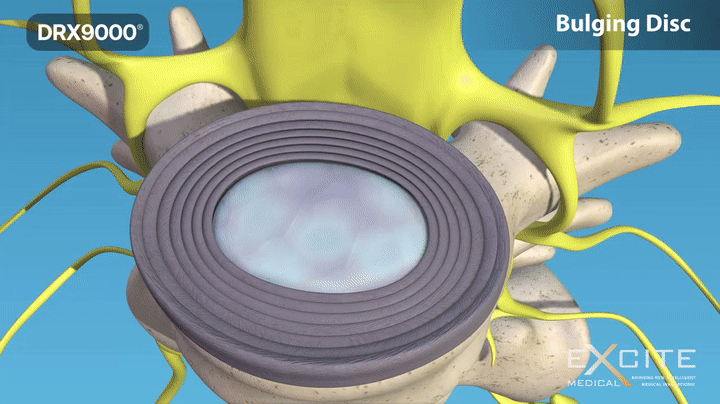Bulging / Herniated Disc
Bulging / Herniated Disc

What Is A Herniated Disc?
Also Known as a Bulged, Slipped, Degenerated, or Ruptured Disc.
To understand what a herniated disc is, we must first understand how the spine works. Your spine is made up of 24 bones stacked into a column, but in order to provide your back with a range of movement, the vertebrae have discs in between each bone to allow some degree of flexibility, allowing you to bend and move your back around. These discs are normally sealed within an exterior casing, but wear and tear can cause this casing to wear down, making a rupture in the casing more likely.
When this happens, your disc can bulge out, which can irritate the nerves in your spinal cord. Depending on the location of the “slipped” disc, this may affect your thighs (a slip in your lower back) or your shoulders (a slipped disc higher up in your neck). No matter the cause or the location, this can cause numbness, tingling, or weakness in the affected areas where the nerves have been disrupted by the stress exerted by the herniated disc because it chokes off nerve function from that area.



Symptoms Of A Herniated Disc
If you’re experiencing pain, numbness, or weakness in your thighs or shoulder, it could be from a herniated disc. This is a spinal problem whose symptoms vary with each patient, but without proper management and examination, this condition could complicate into something far more serious. In addition to back pain, HNP can cause a pain or numbness in the leg, or sciatica.
An Important Note to Remember About Herniated Discs
The disc is NOT a muscle. You can not stretch it, massage it or strengthen it. The disc is a cartilage fluid-filled cushion that is designed to keep the spinal joints separated and protect the spinal cord. Most patients never get the opportunity to do decompression therapy until after chiropractic, physical therapy, pain management and surgery.
Physical Therapy is a great treatment for strengthening the muscles AFTER a disc is healed and stable. Chiropractic is a great treatment to get good motion in the joints of the spine but will not heal a disc. Pain management is a great tool to help control PAIN and inflammation but will not fix a herniated disc. The only two treatments proven to change a damaged disc is either surgery or Non Surgical Spinal Decompression. Much like a cast for a broken bone before plates and screws, we do everything possible to help patients not to have to have invasive procedures by utilizing the Non Surgical Spinal Decompression to stabilize the damaged disc.
If you’re experiencing neck and back pain, numbness, tingling, burning sensation or weakness in your arms or legs, it could be from a herniated disc. This is a spinal problem whose symptoms vary with each patient, but without proper management and examination, this condition could complicate into something far more serious. In addition to neck and back pain, herniated disc can cause a pain or numbness in the leg, which is also called SCIATICA.
Causes Of A Herniated Disc
The main cause of this is misdiagnosed and mistreated disc injuries. Most of us are taught that the disc damage is from getting older, genetics (runs in my family) and “normal” wear and tear and this simply is NOT TRUE. Although these are simple easy to understand answers they are far from the truth. The discs in our spine are cartilage and do not have nerve pain fibers that run to them.
Neurologically, the actual disc is wired much like our hair and fingernails. Meaning, no one can “feel” a disc when it is injured and is why a disc can get injured from some type of trauma at any age and go undetected until it gives out enough to either put pressure on the nerves or cause the spine to not work and move right. All of this makes the muscles hurt so they typically get diagnosed as the problem when the disc is what is damaged.
Imagine having a bulging or herniated disc putting pressure on the spinal cord, causing the spine to not work and move right and all of this causing pain and tight spasm muscles. Unfortunately, the muscles get blamed when the disc is the flat tire. The car is ok, the problem is the flat tire. Typically the spine is ok, the damage is in the disc.
Does it take time for a disc to get to the point of putting pressure on the spinal cord and nerves? The answer is yes. Much like it takes a nail in a tire to slowly lose all pressure. Nonetheless, it doesn’t mean that it is “an age thing”. This is extremely important to understand because with proper treatment through Non-Surgical Spinal Decompression, the disc has an extremely high percentage rate of healing and being stable again without surgery.
The goal for all patients suffering with disc injuries is to always get back to regular exercise as much as possible. Much like you can’t drive on a flat tire or run on a broken leg, no one should try to exercise with physical therapy until after the disc is healed and stable through Non Surgical Spinal Decompression.
Treating A Herniated Disc
First step should always be to have an evaluation by a qualified practitioner. We as a public typically think this would be our family doctor. More often times than not this is not true. Although our PCP may have good intentions, common knowledge of why a disc gets damaged, how to diagnose it or more importantly how to treat it is not common.
This is why a typical automatic routine of pain killers, muscle relaxers, anti-inflammatory medications are prescribed. It is what our healthcare system has established as a protocol to follow. Then, a referral for chiropractic services. After, a referral for an MRI. Once the MRI report shows a damaged disc, typically a referral to a neurosurgeon follows.
A really solid neurosurgeon will only do surgery on approximately 10% of the patients that they see…on the initial visit. After the neurosurgeon, a referral to pain management for an ESI (epidural steroid injection) follows and after the pain is numb a referral to physical therapy is next.
This can be dangerous for the disc. At this point, most patients have an MRI showing a herniated disc (which is not a muscle) putting pressure on the spinal cord or peripheral nerve, had massive pain with possible numbness, tingling and weakness in their arms or legs, have had some type of pain management to deaden this pain and are about to do physical therapy exercises on a damaged disc that will typically worsen with any strenuous activity.
All of these steps are appropriate to minimize pain while trying to identify where the problem is up until the patient is referred for physical therapy. At that point, an appropriate referral would be for Non-Surgical Spinal Decompression Therapy. Along with surgery, it is the only therapy that is actually treating the damaged disc. After a typical disc case has stabilized with decompression and is strong enough to proceed, therapy either with a qualified physical therapist or at home would be appropriate. Long term after spinal decompression therapy, majority of patients are stable in the disc and therefore more stable in the spine and can focus on strengthening . Typically, this is where the need for chiropractic adjustments to get out of pain and constant exercise to keep the muscles loose lessens or is alleviated alltogether.
With properly utilized Non-Surgical Spinal Decompression Therapy, a patient with a bulging or herniated disc, disc degeneration, sciatica from a damaged disc or spinal stenosis can see a very high rate of success because the treatment is actually focused on stabilizing and healing the disc.
Are You Suffering from a Bulging or Herniated Disc,Contact Us Today!
You no longer have to suffer, there are better treatment options available. Contact us to start your new, pain-free life.
